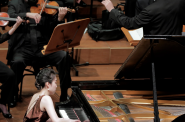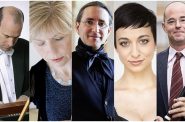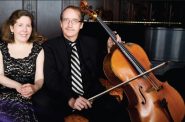The Return of Wendy Richman
The Milwaukee native and crack violist is guest with Prometheus Trio in boffo program.
The Prometheus Trio‘s second concert this season is on Monday and Tuesday evening at the Wisconsin Conservatory of Music. The Trio (pianist Stefanie Jacob, violinist Margot Schwartz and cellist Scott Tisdel) will welcome violist Wendy Richman for a quartet and string trio.
Richman has appeared as a soloist and chamber musician across U.S. and Europe. She is a founding member of the International Contemporary Ensemble (ICE), a Brooklyn-based collective of young musicians “dedicated to reshaping the way music is heard and experienced.” Numerous recordings feature her commitment to new music. Richman is completing doctoral studies at the Eastman School of Music. Her most recent endeavor, Vox/Viola, involves commissions from 25 young composers to write pieces for her singing & playing simultaneously, loosely inspired by Giacinto Scelsi’s Manto III.
Richman has a local connection as well. A long time friend of Jacob’s, she grew up in Whitefish Bay. Her parents, Stephen Richman (a Milwaukee Symphony Orchestra board member) and Fran Richman (former executive director of the Milwaukee Youth Symphony Orchestra) and brother Josh Richman (founder and director of Ruach, the Jewish arts and music organization) are all active leaders in the local music scene.
The program will include a Haydn trio. The sequence of 45 keyboard trios by Joseph Haydn mark the transformation of chamber music in the 18th century. Haydn began with harpsichord works written as courtly background music which relegated cello and left hand to a basso continuo supportive role. By the end of his career, Haydn was a superstar – especially in England where he was rewarded by large concert audiences. Dedicating his final series to a very accomplished forte-piano player, Theresa Jansen Bartolozzi, Haydn wrote virtuosic parts for keyboard.
Ernő Dohnányi wrote an essentially romantic string-only trio, Serenade, Op. 10 (1902) at the start of the 20th century. Its Hungarian folk roots, eclectic character and shifting chromatic tonality distinguish the work from Schubert or Brahms. Dohnanyi managed to cram five very distinct and delightful movements into a 12 minute serenade. Opening and closing with a lively march with a Hungarian flavor, successive movements introduce a lyrical song, a lively fugue, a hymn-like set of variations and a sprightly rondo. The payoff – each instrument has the opportunity to stand out – allows us to appreciate the guest violist more completely than in the more collaborative Faure quartet, also on the program. Schwartz identifies the work as a “tour de force for viola.”
The concert will close with Gabriel Fauré‘s Piano Quartet in C Minor, Op. 15 (1879-84). In contrast to the music of a contemporary like Brahms, there are few “long extended solo melody moments for each instrument” in the Faure, Schwartz observes. This is an ensemble piece – very kaleidoscopic. Knowing that it is French makes you play it differently – (the music is) not vertical, it’s horizontal. The texture is informed by clarity, with enough space for everybody.” That this is a piano quartet, rather than a trio also makes a difference. “Normally the piano is going to outplay the strings. (But) in a quartet you have an extra voice. We can be too loud for the piano. Stefanie is the master of balancing with strings – playing in a way that lets all the string voices be heard.”
The light texture of most of the quartet is grounded in a profound third movement elegy. Critic Kai Christiansen‘s poetic description of this movement is particularly apt:
“The adagio is majestic and profound, serene with a dark streak of poignancy. It opens with an elegiac theme, a stately pavane measured, reflective and somewhat grave. It gathers momentum, reaching with a more emphatic yearning that relaxes again into pastels and a dreamy nostalgia like a French café song whose languorous melancholy savors its own sorrow fondly. A dour chord wakens the reverie into a disorienting drift back through the spinning of time in wide ranging piano arpeggios; a recollection of the poised elegy sinks deeply into the lower strings under the terrible weight of reality. The piano continues to dream, lost, floating skyward like a brightly colored kite against the gray clouds, forever untethered from the gravity of the dark earth below.”
The Prometheus Trio will perform on Monday, December 5 and Tuesday, December 6 at 7:30 p.m. at the Wisconsin Conservatory of Music on 1584 N. Prospect Ave. For ticket information see the WCM website or call 414-276-5760. Additional evening parking is available at Milwaukee Eye Care, 1684 N. Prospect Ave. (at Brady St).
The concert is a part of the Wisconsin Conservatory of Music’s annual Festival of Trees and Music. The week “transforms the Conservatory’s historic McIntosh|Goodrich mansion into a wonderland replete with thousands of lights, sparkling trees and stunning décor.” Join a raffle for one of the many decorated trees to support the work of the Conservatory. Check out the other concerts featuring French chanteuse Robin Pluer, the jazz ensemble We Six and student showcases.
Next February 6 and 7, the trio will perform trios by Mozart, Shostakovich and a trio by contemporary composer Pierre Jalbert written in 2014.
Preview
-
PianoArts Festival Features Rising Stars
 May 28th, 2024 by Michael Barndt
May 28th, 2024 by Michael Barndt
-
Four Nations Ensemble Goes For Baroque
 May 13th, 2024 by Michael Barndt
May 13th, 2024 by Michael Barndt
-
Mozart on Prospect Avenue
 May 9th, 2024 by Martha Brown
May 9th, 2024 by Martha Brown




















